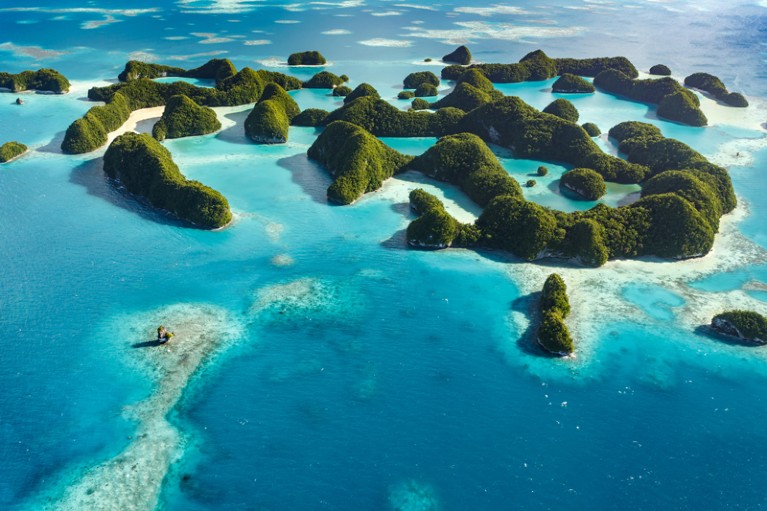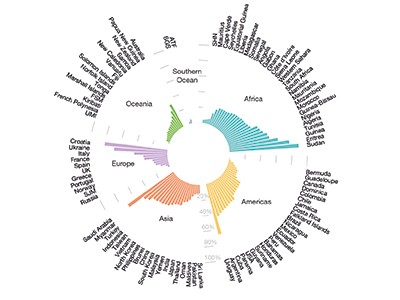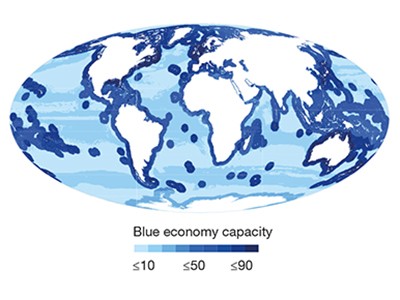
Coral reef shoals in the south Pacific, part of which is a marine protected area.Credit: Pete Niesen/Alamy
After a year of pandemic-induced delays, 2021 is set to be a big year for biodiversity, climate and the ocean. Later this year, world leaders are expected to gather for meetings of the United Nations conventions on biological diversity and climate to set future agendas. Ocean policies will be a priority for both.
Momentum is building for what is called the 30 × 30 campaign — a goal to protect 30% of the planet (both land and sea) by 2030. Last December, the 30% ocean goal was backed by the High Level Panel for a Sustainable Ocean Economy, which comprises the heads of state of 14 coastal nations, including some of the largest countries, such as Indonesia, and the smallest, like Palau. This is an important step.
But this target is ambitious. At present, 15% of terrestrial surfaces are classed as protected, and only about 7% of the oceans have been designated or proposed as marine protected areas — so named because, within them, fishing and other industrial activities are prohibited or restricted. Just 2.6% of the oceans are either fully or highly protected. Although these numbers have been improving, they are behind schedule — a previous global target was to protect 17% of land and 10% of the oceans by 2020.
Achieving the ocean’s full potential for helping humanity will require genuinely sustainable fishing practices, investments in renewable technologies such as offshore wind farms, and zero-emissions shipping. Carbon-hungry seagrasses and mangroves must also be restored. But efforts to achieve these goals inevitably create conflicts, because governments, the conservation community and industry tend to have different priorities. Such disagreements are impeding progress.
Read the paper: Protecting the global ocean for biodiversity, food and climate
Research published in Nature this week could help to resolve some of these tensions when establishing protected areas. Conservationist and National Geographic explorer-in-residence Enric Sala and his colleagues present a model showing how the ocean could be protected in a way that optimizes both environmental and fishing-industry benefits1. This model needs to be studied carefully as talks progress, because it could help nations to see where compromises are possible.
The researchers assessed data on the distribution of ocean biodiversity (taking in 4,242 species); 1,150 commercially exploited seafood stocks; and carbon in marine sediments. They used these data to model the spaces where marine protected areas could be situated to achieve particular outcomes across three main goals. For example, a plan that protects 71% of the ocean could yield 91% of the maximum biodiversity benefits and 48% of the carbon benefits, but with no change to existing fisheries catches. In another scenario, 28% of the ocean could be protected to obtain a maximum increase in seafood catches while securing 35% of the maximum biodiversity benefits and 27% of the maximum carbon benefits.
The model makes it clear that achieving the best outcome on all three goals will require give and take. Nations and stakeholder groups will need to weigh up each goal. That will be hard, but necessary; some countries will have to give a little of their profitable fisheries, for example. And under this model, nations will need to commit to reducing bottom trawling, a fishing practice that stirs up carbon-rich sediments on the sea floor, potentially releasing that carbon. According to one estimate2, the impact of this process on the ocean’s carbon-storage capacity is greater than that of other problems that receive more attention, such as the loss of biological carbon storage when mangroves are cleared.
Read the paper: Enabling conditions for an equitable and sustainable blue economy
Countries must also pay attention to equity and access, and ensure that decisions to create protected areas are made in consultation with affected and often vulnerable communities. December’s high-level panel report estimates that the economic opportunities provided by marine genetic resources, ecotourism, fisheries, renewable energy and carbon credits could reel in a net benefit of US$15.5 trillion by 2050. But, as Andrés Cisneros-Montemayor at the University of British Columbia in Vancouver, Canada, and his colleagues point out in this issue3, many coastal nations lack access to the infrastructure or governance needed to promote what is called a ‘sustainable blue economy’. As might be expected, some nations aren’t equipped to ensure that, say, their local fish stocks are protected from being used in farm feed; or that construction of new ports doesn’t unreasonably affect local communities or ecosystems.
At present, most of the ocean economy isn’t exactly blue. A study of the 100 largest companies in the ocean economy (which together account for 60% of around US$2 trillion in annual revenue) showed that the majority profit from oil and gas. Even Norway, which co-chaired the high-level panel, recently announced 61 new offshore oil and gas licences, as well as its intention to grant sea-bed mining licences as early as 2023. Such moves are disappointing. Green groups and researchers must continue to put pressure on countries to live up to their promises.
World leaders at the upcoming biodiversity and climate meetings have a big task. Expanding the blue economy is difficult given the economic consequences of protecting more of the ocean. But there is now not only momentum in this direction, but also research to show that it can be done. If humanity looks after the ocean, it will look after us.

 Read the paper: Enabling conditions for an equitable and sustainable blue economy
Read the paper: Enabling conditions for an equitable and sustainable blue economy
 Read the paper: Protecting the global ocean for biodiversity, food and climate
Read the paper: Protecting the global ocean for biodiversity, food and climate
 World leaders are waking up to the ocean’s role in a healthy planet
World leaders are waking up to the ocean’s role in a healthy planet
 The ocean in humanity’s future
The ocean in humanity’s future
 Norway’s Prime Minister: Ocean science can boost jobs and wellbeing
Norway’s Prime Minister: Ocean science can boost jobs and wellbeing
 Five priorities for a sustainable ocean economy
Five priorities for a sustainable ocean economy







